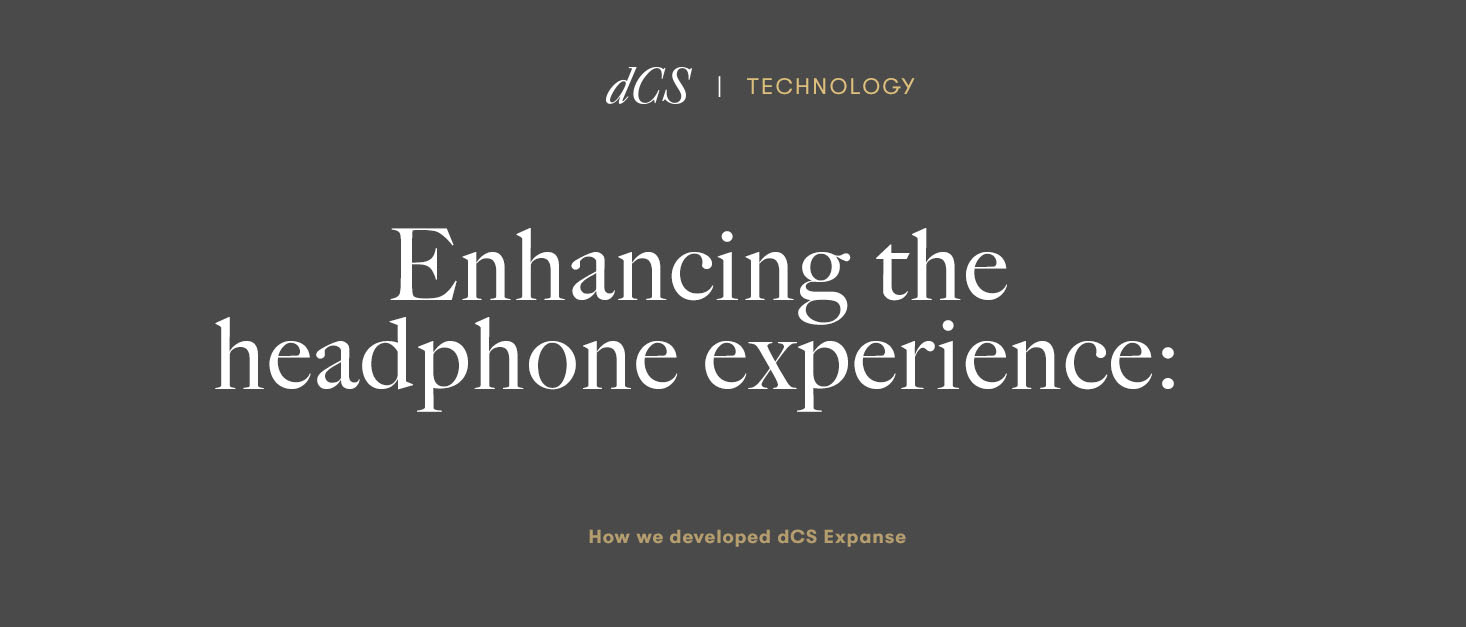
Enhancing the headphone experience: How we developed dCS Expanse
Expanse is a new innovation from dCS that reimagines how sound is optimised for headphones. Here, we take a look at the thinking behind it and how it was brought to life
Tags: Technology & Innovation,While more people than ever now listen to music on headphones, most recordings are still monitored on loudspeakers. Artists, engineers and producers might use headphones to check certain aspects of a mix, but in most professional studios, loudspeaker monitoring is common practice.
Yet listening on headphones and speakers are two very different things. For headphone listeners, this can mean that our experience of a recording doesn’t always match up with what engineers or artists heard during the production process. With Expanse, we set out to address this imbalance and ensure that headphone listeners are able to hear music as the artist, producer or engineer intended.
Understanding headphone listening
To understand how Expanse works, it helps to understand the main differences between headphone and loudspeaker listening and the impact this can have on our experience of music. This topic is covered in much more depth in our technical paper but for now, here’s a brief overview.
When we listen on loudspeakers, sound is projected into the room around us, where it reflects off of various surfaces, including the floor, the walls and our bodies, before arriving at our ears. The signal from each speaker is heard by both of our ears, so the left audio signal arrives at our left ear first and our right a fraction of a second later (where it’s also a little quieter) and vice versa.
When we listen on headphones, sound is projected inside our head, where it forms a kind of arch between both ears. The sound from each signal is paired to the corresponding ear, so our left ear hears sounds from the left channel, and our right hears sounds from the right channel.
Pinpointing sound
In a loudspeaker setup, the reverberation that is generated from sound bouncing around and reflecting off of surfaces plays a crucial part in helping us to identify where that sound is coming from. The difference in time between a sound arriving at our right and left ears provides another important clue, as does the difference in the levels of sound arriving at each ear.
When we listen on headphones, these all-important clues aren’t there, and – depending on how sound has been recorded or mixed – this can leave us struggling to pinpoint the location of sounds that we hear. Instead of music filling the space around us, we can end up with an experience where sound appears to come from inside our head, or right next to one ear. For some listeners, this can cause fatigue or even a physical headache when listening for extended periods of time.
Enhancing the headphone experience
Various technologies have been developed to address these issues over the past few decades, including a technique known as crossfeed, which involves blending sound from the left and right channels of a stereo recording in order to simulate the effect of both signals reaching each ear.
While this process can help to create a more natural soundscape – giving the effect of bringing sound out of a listener’s head and into the room, as it would appear when listening on speakers – it often leads to a loss of reverberation, which as we’ve discussed, is key to providing us with a sense of space and depth.
As a result, many technologies designed to enhance headphone listening have to use artificial reverberation to create a sense of space. This helps, to some extent, but as anyone who’s ever experienced the ‘reverb’ button on a 1980s hi-fi system will confirm, it can end up sounding a little unnatural, resulting in a soundscape that feels quite different to that heard when listening on speakers.
Defining a solution
With this in mind, we set out to develop a new approach to headphone processing – one that could optimise sound without the use of artificial reverberation. After extensive research and development and several rounds of testing, dCS Expanse was launched.
As dCS Technical Director Andy McHarg explains, work on Expanse began following the launch of the dCS Bartók Headphone DAC. After creating a standard crossfeed function for the DAC's release, the dCS R&D team set out to explore what else they could do to bridge the gap between headphone listening and loudspeaker monitoring.
“We launched with a pretty standard version of crossfeed, which was still quite a lot of work and after that had launched, we thought we’d see what else we could do,” says Andy.
Deciding what this new approach should look like required some careful consideration. While the team wanted to bring the headphone experience closer to the studio monitoring experience, they also wanted to avoid creating anything that might interfere with the sound of a listener’s chosen headphones.
“There are some companies that use things like head tracking to recreate the sound of speakers, so when you move your head, it’s like there’s a set of virtual speakers, and we thought that was quite clever … but we also know that if people wanted to listen on speakers, they probably could and actually, a lot of headphone listeners don’t.
“We thought about this and our decision was, ‘we want to make [the headphone experience] sound more natural, but we know that our customers have picked their favourite headphones, so whatever we do has to sound more natural and still sound like their headphones’” adds Andy.
Replicating studio listening
From research, Andy and the team discovered that maintaining reverberation would be key in helping achieve this. Their next challenge was to work out how to add crossfeed without damaging reverb. After extensive research, they discovered that widening incoming audio signals before crossfeed takes place would allow them to do just this and so, in a dCS first, the team developed a technique that allows us to introduce crossfeed and preserve the original reverberation in a recording.
After developing this process, the team also explored how they could further simulate the effects of studio monitoring, and developed an additional technique that allows us to delay the delivery of crossfeed signals by 300 microseconds, recreating the effect of left and right audio signals arriving at our ears at different times.
This technique, coupled with the process of widening audio signals, helped to bring us another step closer to replicating the studio listening experience. But there was another major factor we had to consider.
When we listen on loudspeakers, sound reflects not just off of surfaces, but off of our head, torso and inner ears. This means that how we experience sound depends not just on the acoustics of the room we are in, but our unique physical characteristics.
In order to mirror the studio listening experience, we had to somehow simulate the effects of sound interacting with both our bodies and the space around us. But as we discovered during our research, trying to emulate this process too precisely based on a particular listener’s profile, or a dummy head, could result in audio that sounds great for some and terrible for others. With this in mind, we developed a method of equalising audio that draws on a vast range of data to provide the best possible results for a wide range of listeners, without favouring one particular set of characteristics over another.
Building a prototype
Using the methods outlined above, we were able to develop a basic Expanse prototype on a PC. The team then had to work out how to run Expanse in the digital domain using FPGAs (the code-operated, programmable hardware that exists inside all dCS systems) and ensure the platform was compatible with the various formats that our systems support, from DSD and PCM through to MQA.
Running a platform like Expanse digitally is no easy feat, and requires some serious processing power, but it also allows us to exercise a greater degree of precision and optimise sound without introducing excess noise or distortion – something that would be difficult to achieve with analogue methods.
“Expanse only affects the things it’s meant to, so the noise floor doesn’t go up when you turn it on, distortion doesn’t go up. Those requirements – keeping distortion and noise to a minimum – remain,” adds Andy. It also allows us to ensure that Expanse can be easily updated and refined over time.
Beta testing
Once we had an initial version of the software up and running, we invited a select group of audio experts to help us test it. This involved several rounds of listening sessions at dCS HQ, with the R&D team gathering feedback and making further adjustments after each session.
“It was quite an iterative process,” explains Andy. “[After each round], we’d take the feedback, and we’d say, ‘OK, perhaps there’s a little too much of this here, or too much of that there’, and we’d go away and do some more work to get it right.”
While beta testing is a time-consuming process, it’s vital in helping us ensure that our software and products can cater to a diverse set of tastes and preference, and it’s something that forms a core part of the development process at dCS. As Andy points out, “If you’re going to go to the trouble of having people listen to something, you have to be prepared to listen to their feedback and make changes.”
The software was tested on a variety of headphones, with beta testers comparing results on over a dozen models. “Different headphones have different frequency responses and that can impact what you’re trying to do, so we had to make sure we had something that could work on most models,” adds Andy. It was also trialled on a variety of recordings, from live orchestral recordings to multitrack mixes.
The finished article
After over a year of research, design, development and testing, Expanse was launched on December 21 as part of Mosaic 1.1.1 – an updated version of our Mosaic control app.
The final software offers a choice of two settings: while both perform the same core function, Expanse 2 is a slightly gentler setting, which allows us to preserve the timbre of instruments.
“It’s extremely hard to make one cross feed setting that works for all source material and that’s not just down to whether [the source material] is jazz, or techno, or classical – it’s about how it was mixed and recorded,” Andy explains.
“What you’re trying to do [with cross feed] is reproduce a soundscape, but that soundscape could be a natural one, like the soundscape produced by an orchestra, or it could be something that exists in Brian Eno’s head,” he adds. “By having two filters, we can provide a more extreme version and then a slightly more subtle one that might be better for things like orchestral music.”
Using Expanse
Expanse isn't suitable for all types of music [its effect varies depending on how a track was recorded or mixed], but when engaged with the right track, such as those featured in our Expanse demo playlist, available on Qobuz and TIDAL, it provides a more natural soundscape and a heightened sense of realism.
Whether or not the feature should be left on comes down to your individual preferences and musical tastes. As Andy points out, “If someone is listening mostly to classical music, a lot of those recordings tend to be mixed in much the same way, so you might just set it up and leave it on”, while more experimental headphone users – such as those hopping between multiple genres, or between binaural and stereo recordings – might find it works best on a track-by-track basis. With this in mind, Andy recommends that listeners experiment with the platform during playback to find the setting that best suits your music.
Creating a platform like Expanse is an extensive undertaking, but the R&D team at dCS is well-versed in developing new technologies from scratch. In fact, it’s been a core part of our work for over 30 years, from our early days designing digital converters for professional recording studios, to our work creating playback systems for home listening.
By developing our own processes and platforms, we are able to resolve issues that can have a negative impact on playback and present listeners with an immersive experience that is faithful to the music, and the artist’s intention.
You can find out more about Expanse here.
Expanse is available with the Lina Network DAC, Bartók DAC, Rossini DAC, and Rossini Player.












